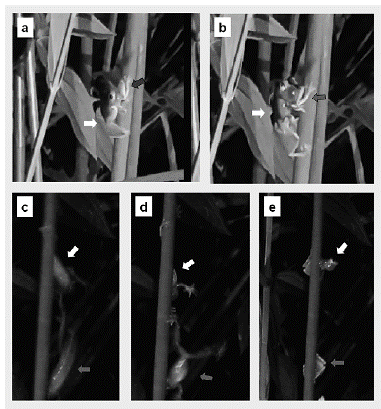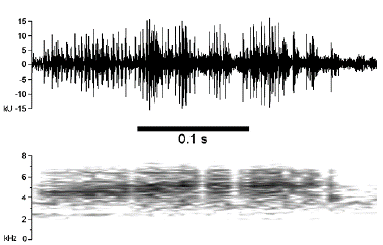Male-male agonistic interactions in animals occur in a myriad of forms and degrees, and the outcomes of such contests have attracted the interest of evolutionary and behavioral ecologists for decades (Collias 1944, Parker 1974, Enquist and Leimar 1983, Arnott and Elwood 2009). In anuran amphibians, males of some species do not show any form of aggressive interactions and tend to tolerate other males even during mating (e.g. multi-male spawning; Kusano et al. 1991, Prado and Haddad 2003). In other species, aggressive interactions are present and can be escalated, with the first emission of vocalizations, which may become more aggressive, followed by chasing, and even male-male fight (Martins et al. 1998, Costa et al. 2020). Aggressive encounters in anurans are common under high densities (Kluge 1981, Wagner Jr 1989), and physical combats include wrestling and jump attacks, lasting from a few seconds to several minutes (Wagner Jr 1989, Wells 2007, Caldwell et al. 2010). Males normally use their posterior limbs to kick the opponent out from the vegetation, maintaining inter-male spacing (Telford 1985). Fights are normally avoided because they can represent injuries for the individuals involved, mainly if they have structures such as spines (Kluge 1981, Nali and Prado 2012). Additionally, during fights, males may emit vocalizations, which are known as fighting calls (Toledo et al. 2015). The exact function of these calls remains unknown, as they would attract more predators and represent extra energy expenditures (Wells 2007, Nali and Prado 2014a).
Reports and detailed descriptions of male-male aggressive interactions are scarce relative to all described frog species, especially in the Neotropics, which harbors a huge diversity of frogs (Frost c2020). One example of this enormous biodiversity is the genus Dendropsophus, which comprises over 100 small-sized species widely distributed in the Neotropics (Frost c2020, Orrico et al. 2020). This genus belongs to the family Hylidae (true tree frogs) and is divided into species groups, one of which is the Dendropsophus microcephalus group, currently containing 37 species (Faivovich et al. 2005, Orrico et al. 2020). Herein we report on different aggressive interactions and describe the fighting call of one of the species of the group, Dendropsophus branneri (Cochran, 1948). This is a small hylid that occurs in the Brazilian Atlantic Forest from northeastern to southeastern Brazil; individuals reproduce in lentic water throughout the year, with higher reproductive activity in the rainy season (Arzabe et al. l998, Frost c2020), and for which social interactions among males were previously unknown.
On 6 Nov 2019, during a field expedition at the Botanical Garden of the Universidade Federal de Juiz de Fora, municipality of Juiz de Fora, State of Minas Gerais, Brazil (21°44'7" South, 43°22'11" West), we observed and made video recordings of two males of Dendropsophus branneri engaging in physical combat (Fig. 1). The behavior started at approximately l9:loh in a permanent pond with grassy margins, from which several individuals called perched all night (air temperature = 22.5 °C). One of the males was perched on a grass, ca. 1 m above the water when another male approached and started the fight. The fight lasted approximately one minute, during which the males engaged in kicking and pushing one another while circling the grass, but both remained approximately in the same vertical position. The fight ended when one of the males apparently attacked the other by using its anterior limbs to make the opponent fall to a lower position on the grass while grasping onto the grass with its feet (Figs. 1c-e). This movement was very fast, lasting approximately 0.5 s. Both video recordings are deposited in FIGSHARE under the link: https://doi.org/10.6084/m9.figshare.12400958. The two males remained still for a couple of minutes without calling activity and were then collected, processed according to McDiarmid (1994), and deposited at the Coleção de Anfíbios da Universidade Federal de Juiz de Fora, Minas Gerais State, Brazil, under the vouchers CAUFJF 2083 (snout-vent length = 18.56 mm) and CAUFJF 2084 (snout-vent length = 18.82 mm).

Figure 1 Physical combat between male 1 (white arrow) and male 2 (gray arrow) of Dendropsophus branneri in the municipality of Juiz de Fora, southeastern Brazil. a Both males had engaged in pushing each other with their anterior and posterior limbs up to this point. b The moment right before the wrestling move, in which male 1 positions itself behind male 2. Notice the inflated vocal sac during the emission of fighting calls. c and d Male 1 holds onto the grass by its feet and apparently uses its anterior limbs to throw male 2 towards the lower part of the grass. e Males remain more distant and do not engage in physical combat until they were collected. See text for the video link.
During the fight, both males emitted vocalizations that were audibly different from the advertisement calls. We extracted a WAV audio file from the video and used the software Raven Pro 1.6 (Center for Conservation Bio-acoustics c2019) to measure call parameters from 10 of the notes emitted. Since it was not possible to determine which male emitted which note, we combined all measurements for the species, as they were very similar. The fighting call of D. branneri was composed of a pulsed note with concatenated pulses (Fig. 2). The notes of the fighting call had a dominant frequency of average 4866.50 ± standard deviation 263.92 Hz (range = 4478.91 - 5167.97), the minimum frequency of 2861.56 ± 158.10 Hz (2706.4 - 3123.7), the maximum frequency of 6819.45 ± 176.50 Hz (6578.9 -7042.1), duration of 0.2492 ± 0.0224 s (0.2098 - 0.2785), and the number of pulses per note of 62.3 ± 7.8 (53 - 79).

Figure 2 Oscillogram (above) and spectrogram (below) of a fighting call of Dendropsophus branneri, in the municipality of Juiz de Fora, southeastern Brazil. Air temperature = 22.5°C. Brightness and contrast = 75, Fast Fourier Transformation = 512. This call was emitted by each of the two males engaged in physical combat (see text for details).
On a second occasion, on 20 Mar 2020 (air temperature = 23°C and relative air humidity = 76%), we observed different interactions at the same pond. At 21:47 h we observed two males on top of each other on a grass leaf, being one larger and one smaller, and shortly after they remained side-by-side. The smaller male jumped to a grass nearby, and the larger male started chasing the smaller male while emitting vocalizations with a higher emission note rate and intensity compared to the advertisement call, likely an encounter call (sensuToledo et al. 2015; not recorded). The smaller male then jumped to a further grass (ca. 1.5 m distant) in a higher vertical position compared to the larger male. After a while, both males started emitting advertisement calls (approximately at 21:51 h) and then stopped. The males were not collected.
Species of the D. microcephalus group, like in most Dendropsophus, may form dense breeding aggregates (e.g. Schwartz and Wells 1985), but physical combats were observed in only a few other species in this group such as D. cruzi (Pombal and Bastos 1998) (Andreani et al. 2018), D. ebraccatus (Cope 1874) (Wells and Schwartz 1984), D. haddadi (Bastos and Pombal 1996) (Silva et al. 2019), D. microcephalus (Cope 1886) (Schwartz and Wells 1985), D. sanborni (Schmidt 1944) (Cardoso 1981) and D. werneri (Cochran 1952) (Miranda et al. 2008), albeit none with video recordings. This is the first description of a physical combat in D. branneri, together with the description of emitted calls. They can be characterized as fighting calls, i.e. emitted specifically during physical combat, also known as combat or fight calls (Toledo et al. 2015). This is the first report of fighting calls for D. branneri, which are rarely described for the genus (e.g., Cardoso and Haddad 1984, Schwartz and Wells 1985). The fighting call of D. branneri is very different from its advertisement call (Nunes et al. 2007): the dominant frequency of the advertisement call (6350 Hz) is higher, the advertisement call duration (0.03 s) is much shorter, and the number of pulses of the advertisement call (4) is much fewer compared to the fighting call described here. Lower dominant frequencies in aggressive contexts have been reported in other hylids (Reichert and Gerhardt 2013, Nali and Prado 2014a,b) and may be related to the assessment of fighting ability by competitors (Parker 1974, Arnott and Elwood 2009), as larger anurans tend to emit lower dominant frequencies (Gingras et al. 2013).
When taken together, the agonistic interactions described here, on two different occasions, are consistent with the presence of escalated (or graded) aggressive behavior in this species (e.g. Costa et al. 2020). In this type of aggressiveness, male-male interactions may include chasing, emission of encounter calls, escalating to the last resource, i.e., physical combat. The actual descriptions of this type of behavior are scarce for the whole genus with examples including D. cruzi (Andreani et al., 2018), D. ebraccatus (Wells and Schwartz, 1984), D. microps (Peters, 1872) (Toledo and Martins 2020), D. minutus (Peters, 1872) (Haddad 1987), D. nanus (Boulenger, 1889), D. sanborni (Schmidt, 1944) (Martins and Jim 2003), D. parviceps (Boulenger, 1882) (Amézquita and Hódl 2004) and D. werneri (Miranda et al. 2008). Detailed reports of aggressive behaviors are important because they allow researchers to test hypotheses on the evolution of territoriality and aggressiveness in frogs (e.g. Nali et al. 2014, de Sá et al. 2019), which would be impossible without the effort of many field zoologists. Therefore, we hope that our results will contribute to the study of reproductive ecology not only within the speciose genus Dendropsophus (Orrico et al. 2020), but also in frogs in general.















